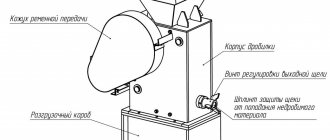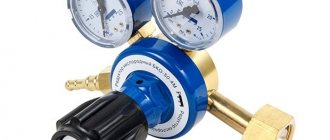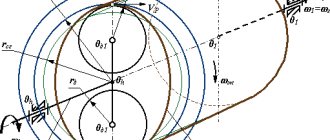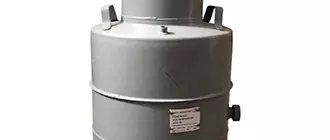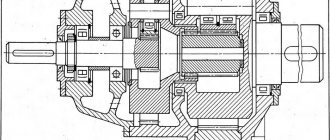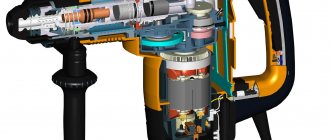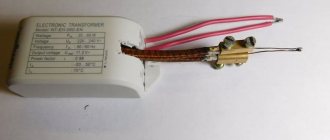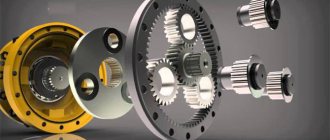Common misconceptions when choosing a gearbox for welding work (argon, carbon dioxide)
Henry Ford once said: “There are no bad cars, only people who made the wrong choice.” Let's talk today about how to choose a gearbox for semi-automatic or automatic welding in shielding gases and make this choice correctly.
Misconception #1
The problem is that many welders choose the UR-6-6 gearbox. Why is he bad? It was originally developed for the food industry back in Soviet times, i.e. it was used for carbonating water, all kinds of drinks, and for preserving sausages, meat, shrimp and other products. Today there is a whole line of gearboxes that are designed directly for welding in shielding gases, for example:
- Universal AR-40/U-30
- For argon AR-40-2
- For carbon dioxide U-30
Or their analogues.
The main feature of these reducers, in contrast to the UR-6-6, is the presence on the low-pressure pressure gauge of a calibration in l/min for each type of gas. This is very convenient for work; you will no longer need to adjust the flow rate by eye, approximately, or look at the tables, as on the UR-6.
Misconception #2
When choosing a small-sized gearbox for regular use when welding in shielding gases, which is not intended for daily use and 100% load. “Small-sized” ones, if used in industry, will not last long. For constant operation, use large-sized gearboxes with a higher-quality reducing unit that can withstand long-term mechanical and temperature loads, more accurately maintain the specified pressure and flow rate, and accordingly, gas losses in such a gearbox will be smaller.
Misconception #3
Many welders think that rotameter gearboxes are more economical than those with gauge flow indication. Actually this is not true. The consumption is the same. The only difference is that the flow rate with a rotameter is measured and displayed in real time, while a gearbox with a pressure gauge shows the flow rate indirectly, i.e. in accordance with the flow washer and the calculated scale in l/min marked on the low pressure gauge.
Misconception #4
Some welders think that gearboxes with two rotameters are designed to connect two welding stations. In fact, they are used for welding reactive materials such as titanium, because when welding titanium, the weld must be protected on both sides. Such protection is also useful when welding critical stainless steel components. A burner is connected to the first rotameter, through which gas is supplied to protect the weld pool, and to the second - a hose through which gas is supplied to the back side of the seam.
Misconception #5
Application (to save money) instead of a specialized reducer, for example, an oxygen or food reducer. This cannot be done, since the latest devices are not designed for welding in shielding gases. Especially when working in a carbon dioxide environment, they will constantly freeze and fail, which threatens the loss of carbon dioxide or argon, which are quite expensive. Therefore, instead of saving, you will lose.
Misconception #6
Do not use heaters when working with carbon dioxide. Carbon dioxide has a high expansion coefficient, so during its evaporation from the cylinder and reduction, the temperature at the reducing valve can drop to -60 degrees. Moisture, which is quite abundant in this gas, crystallizes, which can lead to failure of the gearbox, which in turn will lead to either a cessation of gas supply or its gravity flow. All this will affect the quality of welds.
Use heaters when working with carbon dioxide. They are:
- Flow type
- Built-in on the inlet fitting
- Built-in (we do not recommend purchasing this type)
Misconception #7
Having purchased a gearbox with a rotameter, some welders try to remove the housing and adjust the set screw or valve. There is no need to do this. Everything is already configured by the manufacturer. Your task is to install the control device on the cylinder and connect it to the welding machine.
Add a comment Cancel reply
You must be logged in to post a comment.
Is it worth BUYING, reviews from welders:
- Welding transformer PATRIOT 200AC 102.00 RUR
- Charger GreenWorks G24C RUB 2,490.00
- Voltage stabilizer PRORAB DVR 1000 2597.22 RUR
- Stabilizer Resanta ASN-2000 N/1-C Lux 3610.00 ₽
- Voltage stabilizer Stavr SN-2000 3920.00 RUR
- Welding machine BauMaster AW-79161 3990.00 RUR
- Hitachi AB17 charger RUB 4,076.87
How the device works
It is best to consider the operation of a carbon dioxide reducer using a conventional single-chamber device. Gas is supplied under pressure to the inlet fitting. The incoming substance is controlled by pressure with a pressure gauge installed at the inlet. Getting into the chamber, carbon dioxide puts pressure on the spring, which is pressed down and thereby opens a passage into the chamber cavity. In a carbon dioxide reducer, the cross-sectional area of this section is much larger than the flow area of the fitting, which is why the gas pressure in the chamber is significantly reduced. The pressure drop is recorded by a second pressure gauge, which is considered the output pressure gauge.
Selecting a gearbox for welding
A reducer, in the global sense of the word, is a device that changes any physical indicator, usually in the direction of decreasing or lowering it (reduction).
A welding reducer is a device that is designed to release gas from a nozzle under reduced pressure, since it is highly compressed in the cylinder. Specific pressure indicators depend on the type of gas or gas mixture.
Adjusting the device
Adjusting the gearbox for a carbon dioxide cylinder begins with the fact that it is necessary to adjust the tension of the main spring. For this, there is an adjusting screw, and the tension force depends on what initial pressure is observed in the cylinder with the volatile substance. This spring will lower along with the membrane under the influence of carbon dioxide, passing this substance into the chamber to reduce pressure. This chamber is connected to a shut-off valve, as well as a hose through which the gas flow will reach the welding machine torch.
Which carbon dioxide reducer should I choose? When choosing this device, it is very important to pay attention to the fact that the membrane must be made of oil-resistant rubber, and it must also be very accurately positioned relative to the outlet. It is worth adding here that you can use this type of gearbox manually. To do this, you need to screw in or, conversely, unscrew the adjusting screw, based on the pressure gauge readings. Since a sharp increase in pressure in the chamber is possible, the carbon dioxide welding reducer has a safety valve that protects the main membrane from rupture during a sharp increase in pressure. The safety valve will operate at the moment when the adjusting screw for some reason loses its tightness and more carbon dioxide begins to flow into the chamber than expected.
Color coding
Essentially, a reducer is a pressure regulator for a welding mixture. It is a mandatory part of the equipment for semi-automatic welding machines that use the principle of welding in a protected gas environment. At least two gearboxes (each connected to its own cylinder) are used in a gas welding and cutting installation.
Of course, the best solution would be to choose only a reducer specifically designed for it for a cylinder with a certain gas. There is a strict color coding system:
- blue color with black inscription - oxygen;
- white with red text - acetylene;
- black with blue inscription - technical argon;
- black with white lettering - raw argon;
- black with yellow inscription - carbon dioxide (CO2).
Depending on whether you use gas welding, argon arc welding or carbon dioxide welding, choose the appropriate gearbox.
At the market or in a store, this can be easily done by color - the color of the welding gear matches the color of the cylinder for which it is intended. Blue is for oxygen, black is for argon (also suitable for carbon dioxide), and so on.
Specifications
- vendor code
- Technical characteristics Used gasargon / carbon dioxide Highest throughput, m3/h (l/min) carbon dioxide (CO2) / Argon (Ar) 1.8 (30) / 2.4 (40) Highest gas pressure at the inlet, MPa (kgf/ cm2)15 (150) Minimum gas pressure (at minimum flow rate), MPa (kgf/cm2)0.3 (3) Highest response pressure of the safety valve, MPa (kgf/cm2)0.4-0.5 Overall dimensions, mm, no more than 220 x 160 x 110 Weight, kg 0.5
- Number of pressure gauges 1
- Gas used Argon, carbon dioxide
- Maximum permissible inlet pressure, MPa (kgf/cm2) 15 (150)
- Maximum throughput, m3/h carbon dioxide (CO2) / Argon (Ar) 1.8 (30) / 2.4 (40)
- Brief description Gas used
Is interchangeability possible?
Some types of welding gears are interchangeable, but not all. So, instead of a specialized CO2 reducer for welding, it is permissible to use an oxygen one, but a reverse replacement is absolutely forbidden.
Oxygen is a chemically active substance, a strong oxidizing agent, so special metals and alloys are used to work with them. In addition, oxygen is pumped into gas cylinders under pressure that exceeds the same parameter for carbon dioxide by more than 2 times.
A welding reducer for carbon dioxide screwed onto an oxygen cylinder can last, depending on its quality, from several hours to a couple of weeks. But the sealing membranes, the main structural element, will inevitably be completely destroyed, as a result of which the device will begin to etch.
To avoid erroneous actions by the welder, different threads are made on gearboxes for flammable and non-flammable gases. For flammable - left, for non-flammable, respectively, right.
Similar threads are found in cylinders for cutting and welding. In this case, the oxygen reducer has a right-hand thread. Oxygen does not burn on its own, but supports combustion. It is explosive under certain conditions.
The oxygen reducer used during welding with a carbon dioxide cylinder faces another threat. Carbon dioxide causes parts in contact with it to freeze to -60 °C. Since the pressure regulator designed for oxygen is not supposed to withstand this operating mode, it will also begin to deteriorate.
Rules for the safe operation of propane cylinders
- When using and storing, do not allow the cylinders to overheat (for example, leave them in direct sunlight for a long time);
- It is not recommended to bleed out the propane-butane mixture until the tank is completely empty (under certain conditions it can suck in air, and this is dangerous);
- When transporting, be sure to use plugs and safety caps;
- in case of detection of dents or other defects, the product must be sent for an unscheduled recheck;
- Individuals are allowed to transport no more than five cylinders in one vehicle (they must be separated by spacers from each other).
- It is necessary to constantly monitor the condition of the cylinders, because it is not for nothing that they are considered fire and explosive objects.
What is the gas pressure in a propane tank?
According to GOST 15860-84, the working pressure in the tank should not exceed 1.6 MPa. In this case, the proportion of propane in the hydrocarbon mixture must be no less than 60%. This is very important for the safe operation of gas cylinder installations. Of course, products are designed for significantly higher pressures - more than 5.0 MPa. Production and periodic tests are carried out under a pressure of 3.0 MPa.
Refueling standards
At gas cylinder refilling stations, employees are familiar with the regulations. Since a cylinder that is filled too much can explode or its valve can be torn off. So, if you refuel from a reliable supplier, you have nothing to worry about.
What to choose
It is believed that for domestic welding conditions - short-term, occasional operations - any device that matches the thread of the cylinder is suitable.
Even a carbon dioxide reducer screwed onto an oxygen cylinder (if gas welding is used) or onto a cylinder for a welding mixture of 80% argon and 20% carbon dioxide can withstand an operation like welding a barbecue for a summer house. Another thing is that later this mechanism will have to be thrown away.
A typical example of such a gearbox designed to work with CO2 is the very well-known and popular among old-school welders UR 6-6.
It is compact, inexpensive, and thanks to the presence of two pressure gauges, it makes it quite convenient to determine the flow rate “by eye.” For household welding, high precision is not needed. One pressure gauge shows the residual pressure in the cylinder, and the second is aimed at demonstrating gas flow - liters per minute.
Design versions
Sizes and characteristics of devices must comply with the requirements of GOST 13861-89, ISO 2503-83 and GOST 12.2.052-81. Classification of carbon dioxide reducers can be made according to the following parameters:
- According to the number of working chambers. The predominant number of such devices are of the single-chamber type, however, to improve the stability of operation in conditions of low outside temperatures, double-chamber gearboxes are also produced. The working chambers in such devices are located sequentially.
- According to working conditions. There are ramp, network and balloon reducers. Ramp ones are intended for operation in multi-post areas, and network ones are powered by a stationary network laid from the carbon dioxide station of the enterprise. For the operation of individual posts, cylinder carbon dioxide reducers are designed, which are designed for lower specific gas consumption and a limited range of operating pressures.
- According to the principle of opening/closing the inlet valve, reducers for a carbon dioxide cylinder can be direct or reverse acting. The operating principle of the second type of gearbox is discussed above, and in direct-acting gearboxes all changes in flow and pressure occur in the reverse order. Such gearboxes are less convenient to use and therefore are used much less frequently.
Gearbox selection. Faucets. Gearboxes with flow meters
- Log in to reply to this topic
#21 Argonaut
- Top
- Insert nickname
#22 mat
- Top
- Insert nickname
#23 LamoBOT
- Top
- Insert nickname
#24 mat
- Top
- Insert nickname
#25 energyos
- Top
- Insert nickname
#26 Shurpet
- Participant
- Messages: 4,141
- Saratov city
- Top
- Insert nickname
#27 energyos
Where can I buy it? I can't find it on the Internet.
- Top
- Insert nickname
#28 som
What's wrong with oxygen?
- Top
- Insert nickname
#29 Shurpet
- Saratov city
- Top
- Insert nickname
#30 HUMBLE
energyos , AR40/U30 Donmet
Welding of all types of metal in SAMARA -
- Top
- Insert nickname
#31 energyos
Question: can it be connected directly to the cylinder without any additional gearboxes? There are 150 atmospheres in the balloon
- Top
- Insert nickname
#32 Shurpet
- Saratov city
- Top
- Insert nickname
#33 energyos
Understood! I'll take it! Thank you!
- Top
- Insert nickname
#34 vnuk
- Top
- Insert nickname
#35 Mitka51
It’s best to take our oxygen reducer from the old Soviet model
- Top
- Insert nickname
#36 volgar211
- Top
- Insert nickname
#37 alekscfif
There are offers on the Internet for gearboxes with rotameters for carbon dioxide and argon:
carbon dioxide reducer with rotameter U-30-KR2-P, argon reducer with rotameter DINFLOW N1 3-30, gas flow regulator U 30 / AR 40 R with rotameter (carbon dioxide / argon).
Does anyone have experience working with these? Which one can you recommend for working with a semi-automatic machine, taking into account the criteria: price-quality-reliability. Is built-in heating of the gearbox necessary when working with carbon dioxide, or is a 60-watt light bulb placed in a coffee can enough?
- Top
- Insert nickname
#38 Mitrich83
The presence of heating greatly depends on the conditions in which you are going to cook. If work in the cold is still required, then I would recommend taking the U-30/AR-40-P with a heater.
- Top
- Insert nickname
#39 alekscfif
Mitrich83, thanks for the information and link!
- Top
- Insert nickname
#40 tager03
The question arose of choosing a carbon dioxide reducer.
We have on sale:
5) oxygen reducers from the same manufacturers.
Which gearbox manufacturer is better to pay attention to?
It is planned to use an amateur class inverter P/A for personal needs in equipment repair.
Requirements for devices
Despite the fact that the design features of the equipment are very similar, higher operational requirements are imposed on oxygen reducers. The difference is that O2, unlike CO2, does not liquefy. Due to the absence of this effect, the pressure in an oxygen cylinder reaches 200 atm, while liquefied carbon dioxide is characterized by a maximum pressure of 70-80 atm. Because of this difference, if you install a carbon dioxide reducer on an oxygen cylinder, gradual destruction of the sealing membrane will occur. For this reason, such a replacement is not allowed, however, it is possible to carry out the replacement in the reverse order, that is, installing an oxygen reducer on a carbon dioxide cylinder.
Another significant difference lies in the method of joining. Carbon dioxide gearboxes can be secured using a clamp, while oxygen gearboxes can only be secured using a union nut. This requirement is justified by the fact that with a CO2 leak there is no danger of an explosion or fire, as with an O2 leak. Another small but important design difference is the cleaning filter found in carbon dioxide reducers. The filter is designed not only to purify the gas, but also to prevent the gas from bleeding back into the cylinder, where a surface cushion of gas that has left the liquefied state can form.
Design
There are two types of designs: direct type device and reverse type device. In a direct type device, the gas coming from the cylinder presses on the valve from below and opens it. If the outlet pressure is lower than the operating pressure, the membrane bends and opens the pressure-reducing valve, supplying gas from the cylinder. To regulate the pressure, you must rotate the adjusting screw.
In reverse type devices, adjustment is carried out both by opening the valve and by bending the membrane. To monitor the gas pressure in the cylinder and at the outlet of the device, it is recommended to install two pressure gauges. Reverse type devices are characterized by the fact that their operating pressure increases as the gas in the cylinder is consumed.
KEDR GC produces and sells the time-tested carbon dioxide reducer UR-6 and its improved version KEDR UR-6-6m. They belong to single-stage direct-type bladder reducers and consist of the following elements:
The devices provide a working pressure of 0.6 MPa and have a throughput of 6m 3 /hour. You can get acquainted with the characteristics, order and buy carbon dioxide reducers on the website of the manufacturer KEDR in Moscow.
Scope of application
When using bottled carbon dioxide, you cannot do without a reducer. Most often it is used in the following cases:
gas shielded welding;
in the chemical industry;
for carbonating products in the food industry and serving beer;
to neutralize alkalis (carbon dioxide);
in agriculture to accelerate plant growth;
Sometimes, in the absence of a carbon dioxide reducer, questions arise about its possible replacement with an oxygen one. They are really very similar in size and in the presence of two pressure gauges. But we categorically do not recommend replacing these gearboxes with one another. And although they differ externally only in color, in essence they are completely different devices. The pressure gauge at the inlet of the oxygen reducer is designed for 25 MPa, and for the carbon dioxide reducer it is only 15 MPa. At the output, respectively: 16 MPa and 1 MPa. The safety valves also have different settings: 9 – 10 atmospheres for carbon dioxide and 16.5 – 18 for oxygen.
